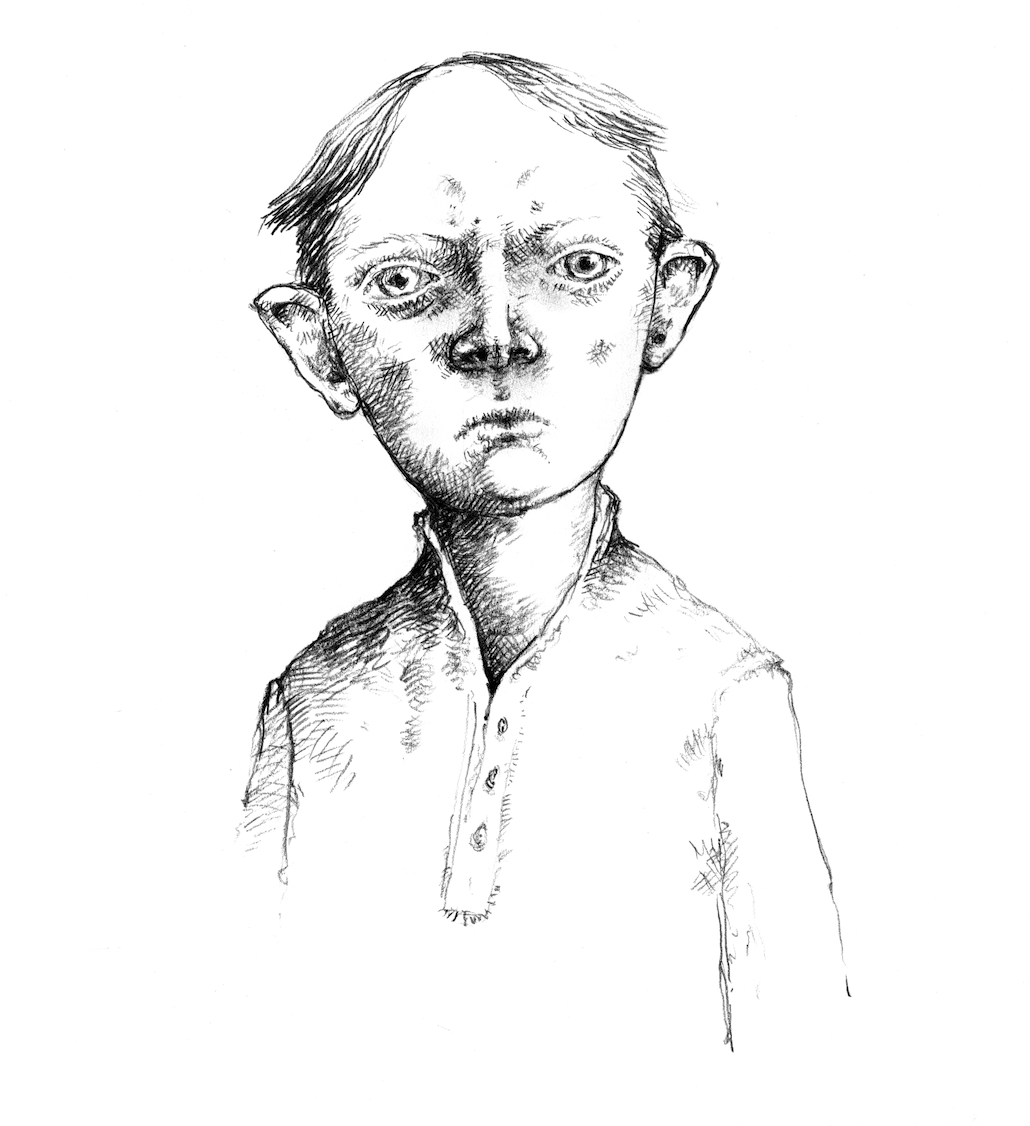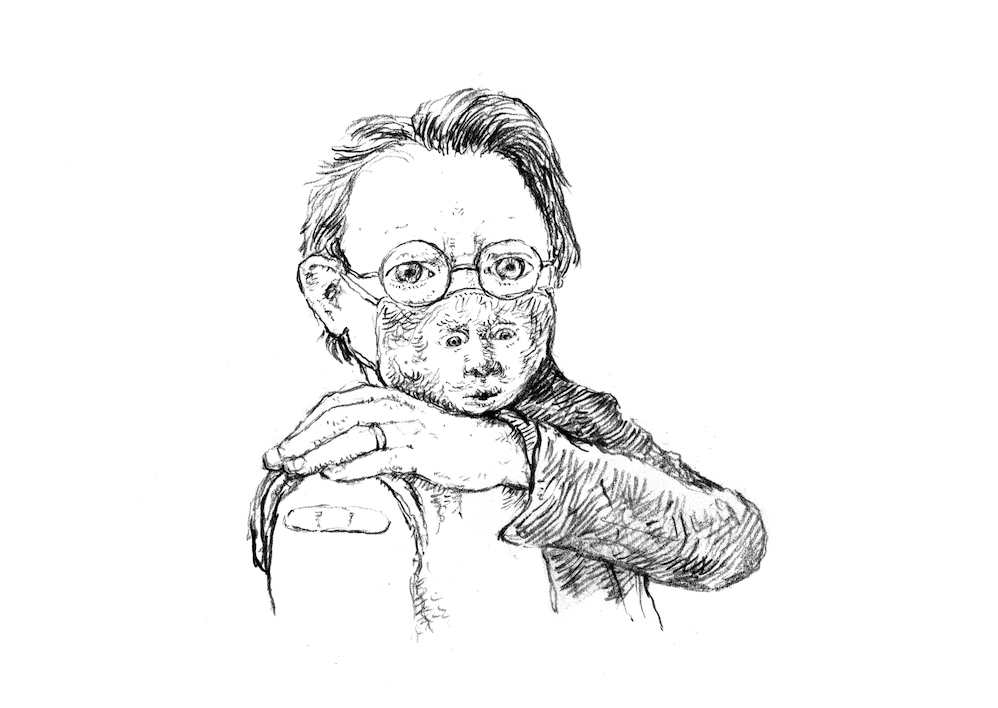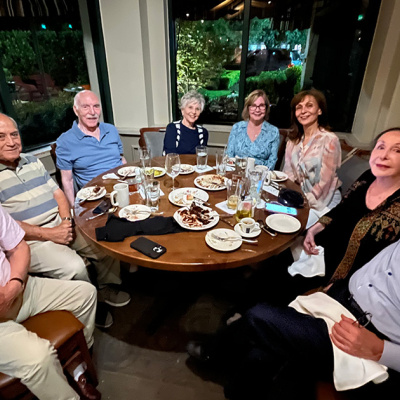A Year of Pandemic in Words and Pictures

People all around the world muddled through the first year of the pandemic—and our collective lockdown—in various ways. Edward Carey, a novelist, illustrator, and professor of English at UT Austin, got through it by using deeply personal musings and sketches to document his life. The following is an excerpt from Plagues & Pencils, his unique and weirdly whimsical COVID-19 memoir, which will be released by University of Texas Press in April.
When I returned from England as the pandemic set in, I was writing a rather bleak novel and I’d got tangled up in it and it didn’t quite feel mine and I was not sure how it worked despite spending many months on it. I’d lost my way. It had happened before. Once I spent 15 years writing a novel, one that only saw the light of day because I abandoned it midway through and swore never to touch the thing again, and only months and months and months later did I start to love it again. Something like that occurred again with this book, and I set it aside. I needed something else. I could not do nothing. I must find something. There was another book I was thinking of writing, had been mulling over for a few months, so perhaps I’d start on that. But I needed something to do instantly, and so I got out pencil and pad and drew the determined-looking young man without exactly meaning to. There, I thought, that’s a start. And if you’ve done one drawing you can certainly draw another. One face will lead to another face, one animal to another animal; slowly, slowly, there’ll be a multitude. And then, in the end, with the passing of time, if you do it and keep doing it, like Geppetto in the sea creature’s belly, you’ll be, with any luck, set free again.
There is something so comforting about a blank piece of paper and the lines the pencil can make upon it. The pencil is a humble object but a versatile one: It can make very faint marks or the blackest black. It is also very forgiving: If you make a mistake, don’t worry, you can rub it out. A pencil can be anything, and drawing requires no great set-up—just a piece of paper and a sharpener, and then it can be kings or trolls, philosophers or grackles. As I posted my first drawing on Twitter and Instagram, and having declared that I would do a drawing every day until we were allowed to be with each other again, I thought, It won’t be long, a month or two. That seemed easy enough then, and a daily drawing would provide at least a small piece of structure for the day. A drawing a day is, after all, not so very much. It doesn’t weigh on one too heavily. It’s a little escape, a hello, a mark of time like the scratches prisoners make on their cell walls. Don’t think about how long it will go on for, focus on the now. Today is here, tomorrow is unknowable.
Very soon the question for me became what to draw next. The second day was, somewhat unimaginatively, a determined young woman, and then a grackle because I love grackles, and then the cat that had become the newest member of our family. But each morning I would scratch my head and wonder what to draw that day. I did Samuel Pepys because I missed London—I already missed it, I’d been there only a few days ago back then and it already seemed like forever. A friend quarantined in an apartment in Rome asked me to draw Daniel Defoe because, like Pepys, Defoe witnessed the Great Plague in the British capital.
After that, other people—including many I’d never met—started putting in requests. Soon I found myself drawing people or animals I’d never otherwise illustrate. Along came a magpie and a goat (Great Orme goats, taking advantage of the lack of people on the streets, were wandering casually from the countryside into the Welsh town of Llandudno). Then came characters from Shakespeare: King Lear and Richard II. Then writers: Mary Wollstonecraft and Virginia Woolf. Characters from mythology or folklore: Medusa, a brownie, Puss in Boots, Baba Yaga, Pesta (an old hag in Norwegian folk tales who is the embodiment of the Black Death), and a plague doctor. Also, more great minds to help us in this strange isolation, consolation from great writers of the past: Michel de Montaigne, Charlotte Brontë, Charles Dickens, Robert Louis Stevenson. I posted a drawing every day, sending a little message in pencil. I was on my way. By then I’d made 26 drawings.
Sometimes I didn’t like the drawings particularly, but I’d made a commitment to do this so I posted one a day, without fail. People started writing back to me, they said they were getting used to seeing a drawing every day and in some small way it was something to look forward to. On I went then, buoyed by kind words. I liked hearing from people, friends and total strangers, and I liked it when other people started showing me their drawings. I felt brief connections, small waves. It was not much, but it was something. People kept mentioning early on in the pandemic how Shakespeare wrote King Lear while quarantined during a plague, and that we must use this time efficiently and energetically and above all not waste it. But I didn’t really hold to that. I thought perhaps we should be kinder to ourselves, take it easy, do things for the love of it, not flog ourselves. Drawing, for me, was a way of breathing calmly. When I got up in the morning, I mostly wasn’t sure what I’d draw that day, but I’d work it out. Requests took me somewhere different, and we all needed to find new destinations in our own heads during this time of shelter. I had no idea what drawings would follow, nor how many drawings would be stacked up by the end of this. I was just taking it—like so many people around the globe—one day at a time. One drawing at a time. A drawing a day to keep the eye off the plague. I write this in the past tense. But that’s not right. That’s make-believe. It’s still going on. It’s not over. There’s no end in sight. I can’t pretend there is.
I always drew as a child. Like so many of us, drawing was a sacred pastime, drawing was my own private language. Hours a day I drew. Just with a pencil mostly. Drawing being an alternative to words, another way of communicating. Drawing was the place I would go to think and to be alone, where my thoughts could wander. I could draw heroes and I could draw monsters. I was very happy to be with a piece of paper. And the drawings I drew were mostly exaggerations, were caricatures, were grotesques; that was just what came out. So many of my drawings, even now, so many years after my father has gone away, have a strong resemblance to him. He had the most expressive face of anyone I have ever known. The whole range of human emotions could play with great swiftness across his rather jowly phiz. We are all influenced by the shape of the humans around us. My immediate and not so immediate family came in all sorts of shapes and sizes and were a wonder for a small child who practised cartooning. I copied Asterix characters a great deal too, and was ever delighted by the antics of the short thin man and the tall fat one.
I’m beginning to forget what life was like before. We used to travel a lot, we were very lucky. We have two kids and we’ve been able to take them to different countries, but no longer.
Now there’s just here and the endless present. My son said just this morning, “I will never take a beautiful landscape for granted again.” He misses Scotland mostly, and the Thames at low tide. The world has closed down and yet we’re still in it. What a little bit of world we have now. These same rooms every day. In these rooms the news of the world, close by and far away, comes to us; it leaks out through our machines. To think, without them, what little we’d know. Geppetto had no news of the world for two years. But we, of course, have it on tap and are addicted to it. What’s happened now? And now? And now? What a year for the world, what a year for America, which is where I’ve witnessed it from. People dying at terrifying rates, numbers that are impossible to understand, 500,000 as I write this. Cruelty across the country. Police brutality. America seeing a hideously ugly portrait of itself. An orange ogre in a white house. Fire. Rage. Blood. Plague.
Death and death and death. And on we go through it. But all this action, for us four, happens off-stage, or on-screen. We don’t see anyone else. Keep your distance. We have a terrible face mask that came free with something we ordered. It has written on it: Don’t touch me. What a dismal sentiment. I’m forgetting faces. I miss people, of course, terribly. Yet every day out of the window there are still people there. I see these individuals walking up and down the street. Can’t see their faces. Only their eyes and the top of their heads. Like a new breed of human, with no nose, no mouth, no chin. Who are they? Don’t get too close. Everyone’s keeping their distance. They remind me, these people stripped of their identity, of the indiscernible noise of the adults in Peanuts cartoons on television, and also of the shoes and bottoms of the trousers—and only ever that—of the humans briefly glimpsed in The Wombles TV show I watched as a child. A show about hairy creatures living on Wimbledon Common and always avoiding humans. As a child, they terrified me, those pieces of people.
Drawing faces is also an act of remembrance. Other people’s mugs, more of humanity. Other faces beyond the three I live with. Most of these faces are from the past; not all, but the majority. They are faces that are mostly recognisable to so many of us—if the drawing’s good enough. Faces we have in common. Those faces that mean something to us, faces of a shared history. Faces that, just by their sight, communicate something to us. To read, and remember, lives in the stationary image of a famous face.
I live in Texas and Texas is where I have been since fleeing London on 14 March 2020. I hadn’t ever meant to live in Texas. It was not one of my life’s aims. As a child I had absolutely no interest in cowboys, for example. Before I lived in Texas, I had no particular desire to see the place. And there’s an awful lot of Texas in Texas. I live pretty much in the centre of it, and that means the sea is a long way away and England quite a lot further. My mother, in her 80s, lives 4,922 miles away from me. A dear friend of ours lives 4.5 miles away and we’ve seen her only once this long time. Austin is the city I live in. It is an excellent city but right now the city is not open; we haven’t seen much of it lately. Sometimes we go on a bit of a drive and it feels strange and possibly even wrong to travel out of our corner. So our reality is really only 47th Street, Evans, Duval, Red River. Or perhaps, to put it another way: sitting room, TV room, bedroom, bathroom, kids’ rooms. I’ve been thinking of Robert Louis Stevenson, who was ill a great deal of his childhood, and of his poem “The Land of Counterpane.” Great mountains and valleys can be made of bedclothes. It’s easy to do, the shrinking of yourself, to make the counterpane, or quilts, into the Highlands. During this pandemic I’ve drawn three planets and I’ve drawn four insects—a praying mantis and a parasitic bee fly (because they were requested), a giant Texan centipede (because I met one and it was large and alarming and something new), and a house fly (because it landed on Mike Pence’s head)—and I’ve gone microscopic once (a tardigrade).
We go on visits around our house here in Austin. We have a lot of stuff and in that stuff we have sought some solace, some hint of other times, of lives beyond our house. We used to go mudlarking when we were in London. Fully licensed by the Port of London Authority on behalf of the Crown Estate, we’d head to the Thames foreshore at low tide and find history in the mud. Proof of other human beings. Animal bones everywhere, like some apocalypse had befallen us—the Thames was the great dustbin of London and everything was thrown into it. But amongst the bones so much else. So much history—layers and layers of it. You might find a Roman mosaic or a Tudor shoe, a shard of Victorian pottery, or clay pipes hundreds of years old. My son once found a Tudor coin from Elizabeth I’s reign, during the time of Shakespeare. Throughout the pandemic, my son has spent hours going through our bits from London’s mud, yearning for the time when he can go back again. On our first time mudlarking, we went with a group under the direction of an archaeologist. At some point, as she explained what this or that was in the mud, she nonchalantly pulled up a square of terracotta tile. One side of the tile was badly scorched. This tile, she told us, might have come from the Great Fire of London in 1666. During the Fire many buildings were pushed into the Thames in an effort to stop the destruction. We kept that tile, we took it home with us to Texas. Perhaps, just perhaps it fell into the Thames, or was pushed, rather, in 1666 when Defoe and Pepys watched London through plague and flame. Or perhaps it is just an old broken piece of tile. In any case it’s a sacred object in this house.
Please don’t misunderstand me: I do love Austin. It’s a great city, there’s so much about it to love: Barton Springs, most of all—a lake in the middle of the city surrounded by nature, where you can swim all year round—but also the old theatre, the Paramount, and Uncommon Objects, where you may find great wonders in a vast antique store (and where I came upon a large bone for my Geppetto book that I pretended my character had found inside the belly of the whale, and, being unable to look out at the world, had painted a skyscape on it, and called it his window). There are really superb independent bookshops in Austin and its food is excellent and its music, above all its music is what it’s most famous for. Then there’s the Harry Ransom Center where I used to go travelling, where, among so very many treasures, are some hairs from the head of Mary Wollstonecraft Shelley, the desk of Edgar Allan Poe, student scribblings by Edward Gorey, paintings by Frida Kahlo and William Blake. I do love Austin, I just wish it wasn’t my only present.
I nearly stopped my daily drawings twice. I’d reached 100 and had drawn my Determined Young Man for the second time, looking a little disheveled, and I thought, Oh dear, that’s enough. One hundred is quite sufficient. Surely time to put away the pencils. I can’t keep going any more, I’ve had it. What’s the point in a drawing a day? No more! I can’t stand it! It’s making me mad! But I reminded myself no one made me do this, it’s entirely self-inflicted, my own damn fault. No one to blame but myself. Why make such a fuss? Stop if you want to. “But,” I whispered to myself, “I don’t want to stop.” Well then, don’t stop, but stop the whining. There were people who encouraged me to keep going, and some people thanked me for the daily drawings and I felt very grateful for that and it made me happy and it’s nice to be happy. Our friend Paul Lisicky would not even hear of me stopping; he said, “no, keep going, just keep going, get on with it. A day at a time. A drawing at a time.”
Yet another day. Today is an otter. Today is Freddie Mercury. Today is Bruno Schulz. Today is Jamal Khashoggi. Today is a Welsh spirit in the form of a black sow. Today is Italo Calvino. Today is an elephant seal. Today is a house sparrow seen on a friend’s knee. Today is Jim Henson, Girolamo Savonarola, Agatha Christie, Zadie Smith. Today is a walrus, today is a naked mole-rat, today is a newt. Today is Yiyun Li and yesterday was Peter Sellers. Today is Dr. Fauci and tomorrow is the Bastille. Today is a heart.
It is Day 365. I have drawn for a full year. By coincidence the drawing to mark this anniversary is a self-portrait with my second vaccine. It’s certainly a precise ending to a year, but I could have had no idea when I started on 19 March 2020 that on 18 March 2021 I would be sitting here with a plaster on my arm. The pandemic certainly isn’t over as I write and so I’ll keep drawing a while longer, but here is a year in plagues and pencils.



















